

| The Verkehrshaus - Swiss Museum of Transport |
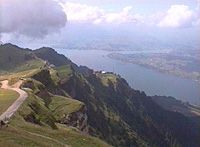 The
Verkehrshaus or the Swiss Museum of Transport and Communication is situated
on the shores of Lake Luzern just half a mile from the centre of the busy
central Swiss town of Luzern.
The
Verkehrshaus or the Swiss Museum of Transport and Communication is situated
on the shores of Lake Luzern just half a mile from the centre of the busy
central Swiss town of Luzern.
The museum first opened its doors in July 1959, and today claims to be the most diverse museum of its kind in Europe. It covers a breadth of areas covering the development of Swiss transport and communication over the last 150 years. There are five main exhibition halls including road, rail, water, mountain and air transport.
But added to the main exhibition halls are extra attractions such as an Imax Film Theatre and the High Flyer, a helium filled tethered balloon that gives passengers a breath taking view over Luzern, the lake and surrounding area from a height of 500 feet.
 Fascinating
as the trains, cars, cable cars and lake steamer exhibitions were, the
main purpose of my visit was to see the Aviation Hall!
Fascinating
as the trains, cars, cable cars and lake steamer exhibitions were, the
main purpose of my visit was to see the Aviation Hall!
The first aviation exhibits to meet you as you enter the museum dominate the central plaza. The DC3 Dakota and the Convair Coranado are both decked out in the colours of the Swiss national airline - Swiss Air.
The four engined Coranado CV990 is not dissimilar to the Boeing 707, and was used for long haul fights to the Middle and Far East and to South America. Technical problems initially delayed the supply of the aircraft, that promised a top speed of nearly 1000km/h. Expensive modifications and poor advertising almost drove the manufacturing company to ruin, as only 37 aircraft were sold.
Today you can walk through the Coranado, viewing the cockpit and seating arrangements and, as you approach the rear of the passenger cabin, there is a short video presentation with archive footage of the aircraft. The large wings of the Coranado also make a good shelter from the rain as I found out during a downpour!
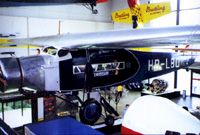 Large
Number of Exhibits
Large
Number of Exhibits
Moving inside the main aviation hall the first thing that struck me
was the number of exhibits, in what can be only described as a moderately
sized space. Upon entering the main door, hanging from the wall to the
right of you, is a Breitling CAP 232 in full vertical ascent! Look directly
in front and above, you find that you are standing under the tail of a
Fokker FV 11a.
The blue Fokker was used in service between 1927 and 1948, and is the oldest maintained passenger aircraft of Swiss airline. Having a range of 800km and at the time, unrivalled comfort, this commercial aircraft was way ahead of the competition. It wasn't until the introduction of American planes such as the Douglas DC-3, was the reign of the Fokker FV11a brought to and end in the 1940's.
But, in spite of speeds twice as fast, air traffic at the time could not seriously compete with the punctual schedules of the railway. Transfers from town centre to airfield, complex flight preparations and delays caused by bad weather largely eroded and time advantage gained by flying.
 Beautiful
Bucker
Beautiful
Bucker
Moving through the various levels of the aviation hall, several aircraft
are immediately recognisable. A Feisler Storch, Bucker Jungmeister, and
even the Breitling Orbitor 2 capsule. This is the balloon that took Brian
Jones and Bertrand Piccard part of the way around the world. The Orbitor
3 finally made the 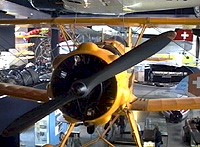 successful
circumnavigation of the world, touching down in Egypt on the morning of
21st of March 1999.
successful
circumnavigation of the world, touching down in Egypt on the morning of
21st of March 1999.
The Bucker Jungmeister 133C is the version featured at the museum. I have seen this aircraft modelled in this colour scheme several times, in particular, Robbe currently produce a small park flyer version of this very aircraft. From 1935 onwards Bucker produced the single seater Bucker 133 Jungmeister (Young Master). The German Air force was first to buy this aeroplane, placing large orders. This order was closely followed by the Swiss, who bought 52 machines of which 46 were built in Switzerland. These aircraft served as aerobatic training planes for military pilots from 1937 until 1968. In 1969 the Swiss Air Force presented the remaining aircraft to the Swiss Aero Club where many are still flying today.
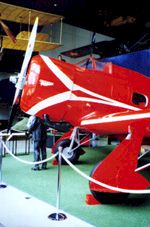 Red
Dog!
Red
Dog!
One exhibit that leaps out at you is the very bright 'Red Dog'. The
Red Dog, a Lockheed Orion could, in 1932, take you to Vienna twice as
fast as conventional means of transport!
When Swissair bought two Orion's in 1932, they pulled off a clever advertising coup: twice as fast as anything the competition could offer, and faster than a fighter plane, the striking 'Red Dog' became part of modern air traffic. The German airline, Lufthansa, didn't believe a flight plan which gave the journey time from Zurich to Munich as 50 minutes, and notified Switzerland that it should surely read '1 hour and 50 minutes!'
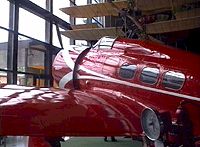 Although
the Orion was always fully booked from then on, passenger transport remained
insignificant as the Orion only had four seats! Just four years later
the Orions were taken out of service, being superseded by the DC-2 in
1935 and later in 1937 by the DC-3, which offered the same speed with
four times as much cargo and seating for 14 to 28 passengers.
Although
the Orion was always fully booked from then on, passenger transport remained
insignificant as the Orion only had four seats! Just four years later
the Orions were taken out of service, being superseded by the DC-2 in
1935 and later in 1937 by the DC-3, which offered the same speed with
four times as much cargo and seating for 14 to 28 passengers.
Of the 35 planes built between 1931 and 1934, only one remains in the world today. This was acquired by the museum in 1976 from America. A team of Swissair volunteers put in thousands of hours of work to restore the plane to its original condition. All traces of two Swissair planes were lost in the Spanish Civil War.
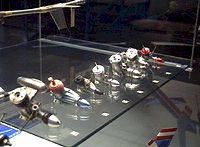
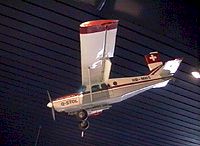 Model
Flying Exhibitions As Well
Model
Flying Exhibitions As Well
Something I've not seen before in a museum, is the area of the aviation
hall dedicated to model flying. A large area of the upper floor has displays
and cabinets full of model aircraft engines and antique radio control
sets. Many of the displays have been loaned by local model clubs. There
are also two computers set up with the Aerochopper model flying simulator.
A wide variety of model aviation is covered, from free flight, gliding,
electric powered and all r/c disciplines such as scale and helicopters.
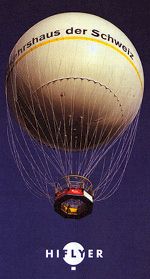 One
Trip Not To Be Missed
One
Trip Not To Be Missed
As you can see from the photos there are many more exhibits than I could
ever describe. There is plenty to do for all the family and one could
spend most of the day at the museum, especially if you were to visit the
IMAX cinema.
One highlight that mustn't be missed, so long as you have head for heights, is the HiFlyer. This is a tethered helium balloon that carries 30 passengers to a height of 500 feet above the museum. We went on the balloon at the end of the day, so there were only about a dozen of us on board. However, the views from the balloon, over Lake Luzern, the town and the surrounding Alps is breath taking. The ride and the views are well worth the extra 20 Swiss Francs and rounded of a great visit to a superbly appointed and interesting day at the Verkehrshaus.
For
more details take a look at their web site at:
www.verkehrshaus.ch
Written
& Photographed by
Peter Dennis - Editor - Flying Sites.